#they have like. crocodilian snouts
Explore tagged Tumblr posts
Text
god one of the best character designs of all time is you make a funny creature and you have it go 👀



#I'm in love with the way tove jansson drew horses#they have like. crocodilian snouts#I was toying with adding marvin the m.artian bc that's a killer design too But#the pupils are not as a dilated that's the important detail#they have to look competely blown out and vacant#also I have to admit it. the designs of security breach are really fantastic. like those glam animatronics.. they are so cool ngl#if it weren't for the scott scuzz over the whole thing I'd prob check more of it out
26 notes
·
View notes
Text

Aug ABSOLUTELY deserves the praise, @ryukikit. St. Augustine Alligator Farm is one of my favorite animal facilities, hands down. It's a pretty zoo, doable in an afternoon if you kinda like crocodilians, or an all day affair if you REALLY like crocodilians. Here are my favorite things about it and why I think it's worth supporting.
1. They keep animals in interesting social groups.

Crocodilians are heavily involved parents, but most places that breed them don't have the enclosure space to let the babies stay with the parents. St. Augustine does. One of my favorite groups was their crèche of slender-snouted crocodiles. They had the parents and then a yearling cohort and a new hatchling cohort. This aligns with how these guys live in the wild- the babies stick around longer! They have the space for it, and they are very in tune with the social needs of their animals.
Very, very few zoos can keep their baby crocs with the adults and still perform maintenance and animal health checks safely. This doesn't mean these facilities are bad- it just means that they have different management practices. And frankly, a lot of these species aren't frequently bred elsewhere. Your average zoo doesn't need a setup where you can have a multiyear crèche for slender-snouted crocodiles. Some species have better success when the young are pulled early, and some zoos are better set up to raise out any offspring separately or behind the scenes. Every facility's practices are different, and this just happens to work well at St. Augustine and be really enjoyable to see as a zoo patron.
Crocodilians are exceptional parents and very protective. It's a sign of incredible animal management practices and animals that feel very comfortable with staff that St. Augustine can do this with nearly every species they breed.
2. They understand the social needs of their animals.
Some crocodilians are social. Some are solitary. Some can live happily with a member of the opposite sex but get territorial around members of the same sex. St. Augustine pays incredible attention to their social groupings to ensure that they aren't just meeting the animals' physical health needs but their social needs as well. They do continuous scientific research about social structures in crocodilians, taking blood samples to test stress hormones and observing stress behaviors to see how group dynamics change.

For example, St. Augustine is home to one of the world's largest known living saltwater crocodiles, Maximo. And his comparatively tiny mate, Sydney. During the educational presentations with these two, they point out that even their monster of a croc needs his social group- he won't eat if she's not around and he is calmer during medical checks if he can see her. These animal share a deep and special pair bond, and they make sure to talk about how the social aspect of these animals' lives is integral to their care. It's a unique aspect of the way they talk about these animals, because he IS a spectacle and he IS a sensation, but they don't talk about him like he's a mindless killing machine- they talk about him like he's a big, complex predator with social needs like any other animal. Aug is the only facility I've been to where the emotional and social needs of crocodilians is part of the education they provide guests- and speaking of education...
3. Their demos and presentations are extremely good.
The presentations at St. Augustine are some of the best I've ever seen, and I've seen literally hundreds of animal talks on everything from aardvarks to zebras. But as you... can probably tell from my blog content, I've spent a lot of time learning about and working with reptiles. I really enjoyed all of their presentations because they are very scientific about things and avoid sensationalism. They really want you to be fascinated by these creatures and love them- but more than anything else, they want you to respect them.
Also, they do a really good job handling their ambassadors. I really enjoyed something as simple as watching an educator tell us about snakes. Throughout the whole presentation she made sure that most of the snake's body was looped in her hand. The snake was always supported and was very calm. She gave the snake plenty of head room so that it didn't feel constricted- it was just good handling all around.

But also, the presentations made it clear how much the park cares about the animals' well-being. When they do the feeding and training presentations, they make it very clear that the animals' participation is entirely voluntary. They do things differently for their 9-foot saltie and their 16-foot saltie, because the 16-footer is so large and heavy he actually struggles walking on land sometimes. They adapt their programs and his care to ensure that he's completely comfortable- and he didn't actually participate in the whole feeding when I was watching! At no point did they try to push him into anything uncomfortable; they offered, he didn't engage, and they moved on. It was a clear expression of his boundaries, and I really appreciated how much his caretakers respected that.
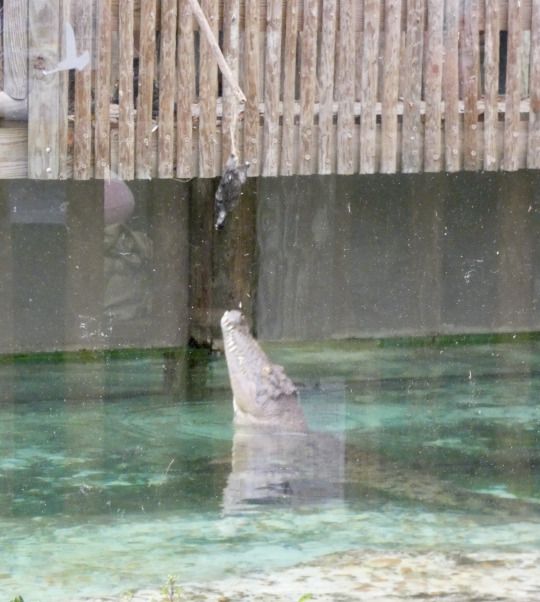
4. Ethical Interactions
I've been to... a lot of tourist locations in Florida that have animals you can hold. Almost always against my will! Many of them are pretty terrible, and you don't actually learn much, if anything. But I really found that to not be the case at St. Augustine. Every single animal presentation and interaction opportunity was accompanied by education about the animal's biology, habits, and- crucially- their conservation status.
When I held a baby alligator at St. Augustine, the proctors- there were two, one to ensure I was holding the gator correctly and the other to educate- were very informative about the role alligators play in their ecosystem and their conservation history. The animals were all properly banded, and one of the two proctors was there to ensure that none of the baby alligators were uncomfortable. As soon as they started getting squirmy or tense, they were removed, unbanded, and taken to an off-exhibit area to relax. And when the babies age out of petting size, they just go in the lagoon to live with others of their species. I saw one upset alligator the entire time I was there, and he was clearly upset that his escape attempt was foiled by a keeper during my nursery tour.
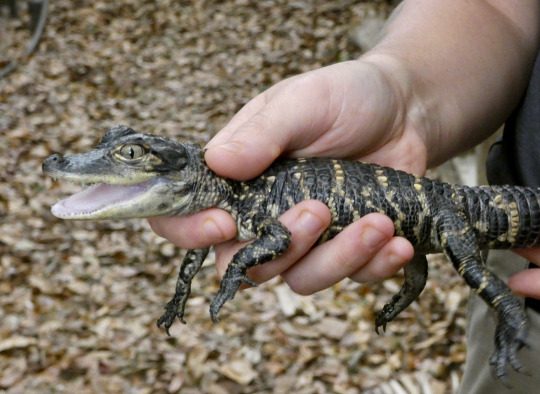
Even though he's restrained in this shot, you can see that his full body and tail are supported, and the grip, while firm, is gentle. He's distressed, but after I took this picture, she put him in his enclosure and he calmed down immediately.
Sometimes when you have petting attractions with baby animals, those animals... don't have a happy ending. (See: cub petting.) But St. Augustine's program is fine- the gators are all aged out of wanting to have mom around, there's no declawing/defanging, and they're handled with care. And it's worth it, because people love what they understand. St. Augustine was integral in raising public awareness about alligators back in the 60s when they were endangered, and now they're thriving- largely in part to programs like St. Augustine getting people to care.
And speaking of getting people to care, let's talk about their research.
5. Shared Research Results
St. Augustine is also home to more species of crocodilian than anywhere else in North America- all of them, usually. (They didn't have a Tomistoma when I visited- that may have changed.)
Because of this species diversity, it's an incredible research resource. Having every species means that you can do a lot of work comparing their behaviors, their growth patterns, and more. They've been a major research site for crocodilian biology since the 1970s. Today, they're one of the key sites for studying crocodilian play and social behaviors. They actually maintain a blog where they post copies of papers that were written using their animals, meaning that you can actually see the results of the research your admission helps fund. You can see that right here: https://www.alligatorfarm.com/conservation-research/research-blog/
All of this adds up to a zoo that provides a unique experience, tons of actual education, and transparency about what its research and conservation steps actually are. St. Augustine's come a long way since its opening in 1893, and they really do want you to leave with a new respect for the animals they care for. Ultimately, if you're a fan of reptiles, you can feel good about visiting the St. Augustine Alligator Farm- their care and keeping are top of the line, they do a ton of innovative conservation research and support for conservation organizations, and you can see this animal there:
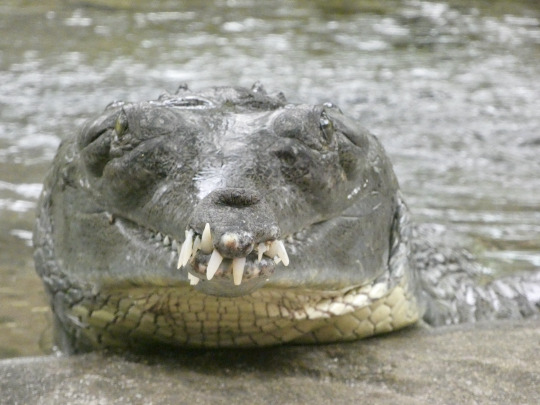
(Gharial from the front. Nothing is wrong with her that's just what they look like from the front.)
6K notes
·
View notes
Text
Fossil Crocs of 2024
Another year another list of new fossil crocodilians that greatly expand our knowledge of Pseudosuchia across deep time. Happy to say that this is my third time doing this now, so I'm not going to bog you down with the details and get right into it.
Benggwigwishingasuchus
Our first entry, sorted by geological age of course, is Benggwigwishingasuchus eremicarminis (desert song fishing crocodile) from the Middle Triassic (Anisian) of Nevada. It was a member of the clade Poposauroidea, which some of you might recognize as also containing such bizarre early croc cousins like Arizonasaurus and Effigia. Also notable about Benggwigwishingasuchus is that it was found in the Fossil Hill Member of the Favret Formation. Why is that notable? Well the Fossil Hill Member preserves an environment deposited 10 km off the Triassic coastline and also yielded fossils of animals like Cymbospondylus, the giant ichthyosaur. Despite this however, Benggwigwishingasuchus shows no obvious signs of having been a swimmer or diver. Instead, its been hypothesized that it was simply foraging around the coast and might have been washed out to sea.
Artwork by Joschua Knüppe (@knuppitalism-with-ue) and Jorge A. Gonzalez
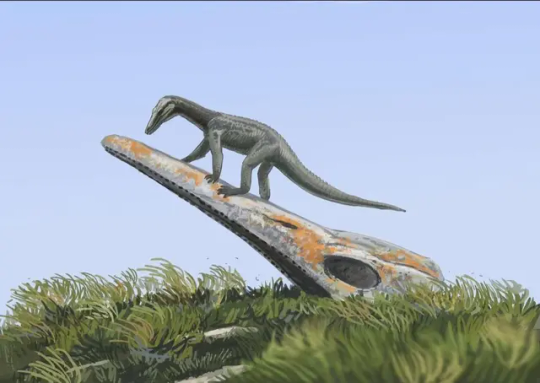
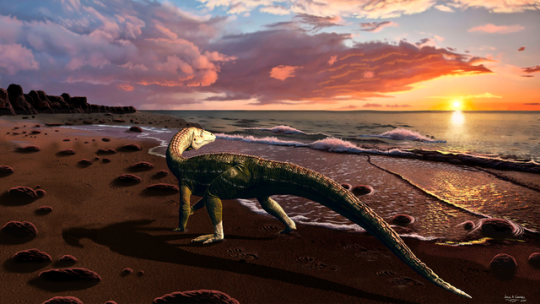
Parvosuchus
Fast forward some 5 million years to the Ladinian - Carnian of Brazil, specifically the Santa Maria Formation. Here you'll find the one new genus on the list I did not write the wikipedia page for: Parvosuchus aurelioi (Aurélio's Small Crocodile). With only a meter in length, Parvosuchus is amongst the smallest pseudosuchians of the year and a member of the aptly named Gracilisuchidae. Santa Maria was actually home to multiple pseudosuchians, including the mighty Prestosuchus (and its possible juvenile form Decuriasuchus), the small erpetosuchid Archeopelta and larger Pagosvenator and one more...
Artwork by Matheus Fernandes and Joschua Knüppe
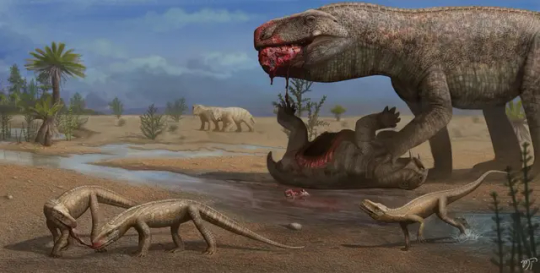

Schultzsuchus
Yup, Santa Maria has been eating good this year. Before the description of Parvosuchus, scientists coined the name Schultzsuchus loricatus (Schultz's Crocodile). Now this one's not entirely new and has long been known under the name Prestosuchus loricatus (by which I mean since 1938). What's interesting is that this new redescription suggests that rather than being a Loricatan, Schultzsuchus was actually an early member of Poposauroidea like Benggwigwishingasuchus. Even if it was no longer thought to be close to Prestosuchus, it was liekly still a formidable predator and among the larger pseudosuchians of the formation.
Artwork by Felipe Alves Elias

Garzapelta
Our last Triassic pseudosuchian and our only aetosaur of the year came to us in the form of Garzapelta muelleri (Mueller's Garza County Shield). It comes from the Late Triassic (Norian) Cooper Canyon Formation of, you guessed it, Garza County, Texas. As an aetosaur, the osteoderms are already regarded as diagnostic, tho unlike some other recent examples there is a little more material to go off from. It's still primarily osteoderms, but at least a good amount and even some ribs.
Artwork by Márcio L. Castro

Ophiussasuchus
Our only Jurassic newcommer is Ophiussasuchus paimogonectes (Paimogo Beach Swimmer Portuguese Crocodile), but arguably you couldn't find a better posterchild for Jurassic crocodyliforms. This new lad is a goniopholidid from the Kimmeridgian to Tithonian Lourinhã Formation, yup, Europe's Morrison. It's anatomy is perhaps not the most exciting, like other goniopholidids it had a flattened, very crocodilian-esque snout and was likely semi-aquatic like its relatives.
Artwork by @manusuchus and Joschua Knüppe


Enalioetes
Another quintessential group of Jurassic crocodyliforms are the metriorhynchoids, however, 2024's only new addition to this clade was actually Cretaceous, specifically from the earliest Cretaceous (Valanginian) of Germany. Like Schultzsuchus, Enalioetes schroederi (Schroeder's Sea Dweller) is new in name only, as fossil material has been found at the latest in 1918 and given the name Enaliosuchus "schroederi" in 1936. This kickstarted a whole series of taxonomic back and forth until the recent redescriptoin finally just gave it a new name and settled things (for now). Looking back I realize that I really need to take the time and fix up the Wikipedia page. Tho I've written its current status, I was kinda limited by being on vacation and never dived into the description section.
Artwork by Joschua Knüppe and Jackosaurus
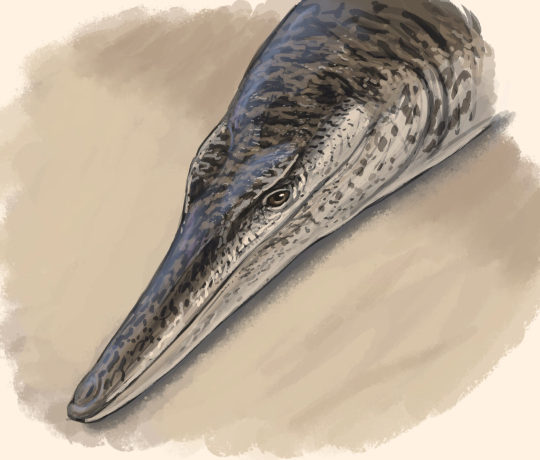

Varanosuchus
Another Early Cretaceous crocodyliform is Varanosuchus sakonnakhonensis (Monitor Lizard Crocodile from the Sakon Nakhon Province), described from Thailand's Sao Khua Formation. It lived around the same time as Enalioetes, but otherwise couldn't have been more different. Where Enalioetes was fully marine, Varanosuchus was more a land dweller as evidenced by the deep skull and long, slender legs. At the same time, some other features, like its more robust limbs compared to its kin, might suggest that Varanosuchus could have still spent some time in the water like some modern lizards. Tho one might be reminded of Parvosuchus from earlier, Varanosuchus is a much more recent example of small terrestrial croc-relatives, the atoposaurids, which are much closer to todays crocodiles and alligators.
Artwork once again by Manusuchus

Araripesuchus manzanensis
Yet another example of a small, gracile land "crocodile" comes to us in the form of Araripesuchus manzanensis (Araripe Basin Crocodile from the El Manzano Farm). And once again, it belonged to a completely different group, this time the notosuchian family Uruguaysuchidae. Now Araripesuchus is well known as a genus, in part due to the work of Paul Sereno and Hans Larsson (who popularized the names "dog croc" and "rat croc" for two species). Tangent aside, A. manzanensis is known from the upper layers of Argentina's Candeleros Formation, corresponding to the Cenomanian (earliest Late Cretaceous). The same locality also yielded A. buitreraensis, from which A. manzanensis can be distinguished on account of its blunt molariform teeth in the back of its jaw. This dentition, which corresponds to a durophageous diet of hardshelled prey, could explain how it coexisted with the related A. buitrensis at the same locality, allowing the two to occupy different niches. There is a neat little animation done for this animal you can watch here.
Artwork by Gabriel Diaz Yantén
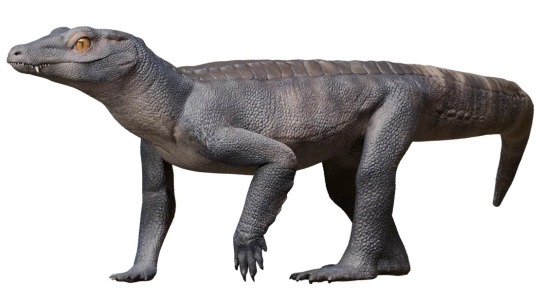
Caipirasuchus catanduvensis
We're staying in South America but moving to Brazil's Adamantina Formation for our next entry: Caipirasuchus catanduvensis (Caipiras Crocodile from Catanduva). This one is a little more recent, tho the age of the Adamantina Formation is a bit of a mess far as I can tell, ranging anywhere from the Turonian to the Maastrichtian. One could also argue that C. catanduvensis is part of the "lanky small croc club" that Parvosuchus, Varanosuchus and A. manzanensis belong to, but I feel that the very short snout helps it stand out from that bunch more easily. Anyhow, Caipirasuchus catanduvensis is a member of Sphagesauridae, related to Armadillosuchus, and herbivorous. What's really interesting tho is that the internal anatomy suggests the presence of resonance chambers not unlike that of hadrosaurs, possibly suggesting that these animals were quite vocal. This could also explain why baurusuchids appear to have had very keen hearing.
Artwork by Joschua Knüppe and Guilherme Gehr
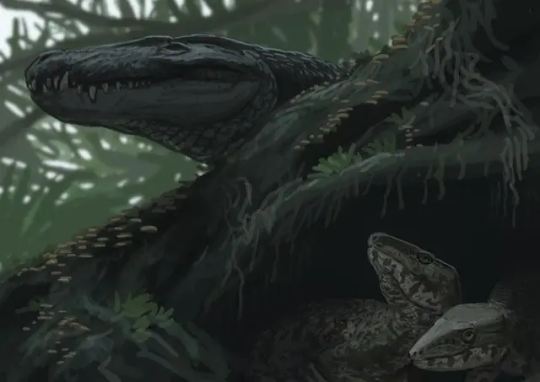

Epoidesuchus
We're staying in the Adamantina Formation for our last Mesozoic croc of the year, Epoidesuchus tavaresae (Tavares' Enchanted Crocodile). Tho also a Notosuchian like Araripesuchus and Caipirasuchus, this one belongs to the family Itasuchidae (or the subfamily Pepesuchinae depending on who you ask), which stand out as being rare examples of semi-aquatic members of this otherwise largely terrestrial group. Epoidesuchus was fairly large for its kin and had long, slender jaws. Like I said, Epoidesuchus and its relatives were likely more semi-aquatic than other notosuchians, something that might explain the relative lack of semi-aquatic neosuchians across Gondwana. They aren't absent mind you, but noticably rarer than they are in the northern hemisphere.
Artwork by Guilherme Gehr

And thus we move into the Cenozoic and towards the end our or little list. From here on out, say goodbye to Notosuchians or other weird crocodylomorphs and get ready for Crocodilia far as the eye can see.
Ahdeskatanka
The first Cenozoic croc we got is Ahdeskatanka russlanddeutsche (Russian-German Alligator), which despite its name comes from North Dakota, specifically the Early Eocene Golden Valley Formation. Ahdeskatanka is similar to many early alligatorines like Allognathosuchus in being small with rounded, globular teeth that suggest that it fed on hardshelled prey. This would have definitely helped avoid competition in the Golden Valley Formation, which also housed a second, similar form not yet named, a large generalist with a V-shaped snout similar to Borealosuchus and the generalized early caiman Chrysochampsa, also large but with a U-shaped snout.
Artwork by meeeeeeee

Asiatosuchus oenotriensis
We had an alligatoroid, so now its time for a crocodyloid. Asiatosuchus has been recognized from the Late Eocene Duero Basin of Spain for a while now, but now we have a name: Asiatosuchus oenotriensis (Asian Crocodile Belonging To The Land Of Wine). Asiatosuchus is a complex genus, most often not really forming a monophyletic clade and likely representing several distinct or at least successive taxa that form the "Asiatosuchus-like complex". Within this complex, A. oenotriensis is thought to have been close-ish to Germany's Asiatosuchus germanicus.
Artwork by Manusuchus

Sutekhsuchus
Rounding out the trio of major crocodilian clades is Sutekhsuchus dowsoni (Set's Crocodile/God of Deception Crocodile), representing our only gavialoid of the year. Originally described as Tomistoma dowsoni in 1920 based on fossil remains from the Miocene of Egypt, Sutekhsuchus has been at times regarded as distinct and at other times lumped into Tomistoma lusitanica. It was one of several early gavialoids to inhabit the coast of the Tethys during the Miocene and appears to have been most closely related to the genus Eogavialis, clading together just outside of the American and Asian gharials. A fun little personal anecdote, I prematurely learned about this one due to a friend highlighting the name in a study on Eogavialis. Never having heard of "Sutekhsuchus" I took to google scholar, where I found a single result: a reference to the then unpublished description, which naturally I ended up eagerly awaiting.
Artwork by Manusuchus and Joschua Knüppe
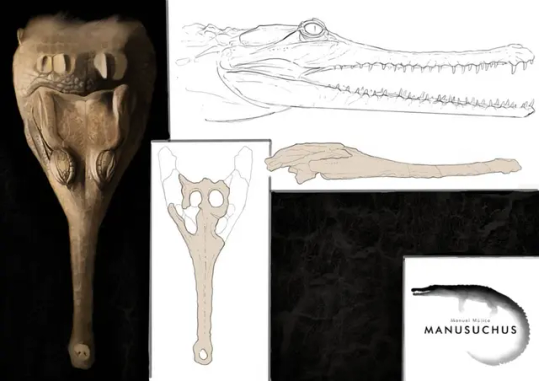
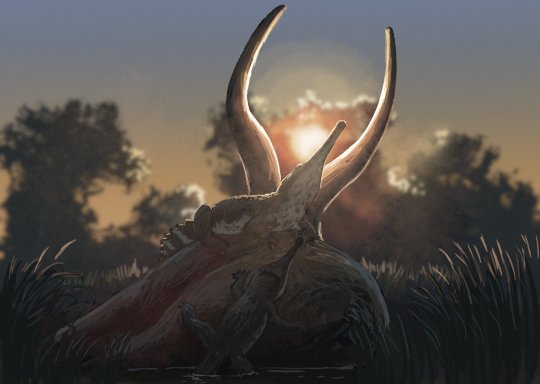
Paranacaiman
Two more and we're done. First, completely arbitrarily, Paranacaiman bravardi (Bravard's Caiman from Parana) from the Miocene Ituzaingo Formation of Argentina. Material of this genus has originally been referred to Caiman lutescens, described in 1912 but now considered a nomen dubium. Paranacaiman is known from limited material only, just the skull table, but that would indicate a "huge" animal. My personal scaling recovered a size of almost 5 meters in length, similar to large black caimans today.
Once again, credit to me

Paranasuchus
Last but not least, Paranasuchus gasparinae (Gasparini's Crocodile from Parana). Coming from the same deposits as Paranacaiman, this one too has been known as a species of Caiman for some time before being assigned its own genus, though it at least got to retain its old species name. Alas, I have not scaled it myself, tho its material is at least more extensive than that of Paranacaiman, including even parts of the snout. A little nitpick because I don't have much to say, but I personally think the name was ill conceived. On its own both Paranacaiman and Paranasuchus are fine names don't get me wrong, but together, coined by the same authors in the same study no less, they strike me as needlessly confusing to non experts. Both are caimans, both are from Parana, so the distinction between "Parana Caiman" and "Parana Crocodile" is entirely arbitrary and doesn't really distinguish them. Not helped by the fact that they are even closely related in the original description. Other than that tho another good addition to our understanding of fossil crocs.
No artwork on this one, but fossil material from Bona et al. 2024

And that wraps up 2024. I hope This post, or my posts throughout the year or even my work on Wikipedia has helped to make these fascinating animals just a little bit more approachable and a massive thanks to all the artists who took their time to create fantastic pieces featuring these incredible animals. Special shout outs to Manusuchus, who diligently illustrated a lot of the featured animals and Joschua Knüppe, who had to listen to me suggest Ahdeskatanka every Sunday for about two months straight now.
Fossil Crocs of 2023
Fossil Crocs of 2022
#paranasuchus#paranacaiman#ahdeskatanka#sutekhsuchus#ophiussasuchus#epoidesuchus#caipirasuchus#araripesuchus#enalioetes#parvosuchus#benggwigwishingasuchus#schultzsuchus#garzapelta#varanosuchus#paleontology#prehistory#palaeoblr#long post#fossil crocs of 2024#paleo#paleonotlogy#crocodilia#crocodylomorpha#pseudosuchia#fossils#2024
234 notes
·
View notes
Text


Kinda went crazy on dragon teeth anatomy! Biology geeking out under the cut
Bogsneak dragons are very crocodilian in appearance, and the fact that they prefer swampy environments definitely lends to this. Out of all the crocodilians, I’d say they resemble alligators the most due to the thicker, rounded snout, and the way the upper teeth poke out from their jaws; Crocodiles visually show both upper and lower teeth when the mouth is closed, while alligators only show upper teeth. Their teeth structure is like alligators; they’d possess around 74-80 sturdy, razor-sharp teeth specialized for vice-gripping their prey. Unlike alligators, Bogsneaks possess a forked tongue. It reminds me very much of a Komodo dragon's tongue, and I imagine they would use it to taste air as well. Bogsneaks eat meat and plants. Alligators are carnivores, but they have also been reported to eat various fruits as well!
Coatls are easy in one sense; they’re obviously snake dragons, but the question is… what snake? I’d argue that they’re visually similar to cobras, with the feather crest resembling a cobra hood, the head being vaguely cobra-shaped, and the fangs poking out of their mouth (cobras have permanently erect fangs). There’s two big differences here though; for one, Coatls are not said to possess venom. For another, Coatls only eat seafood, while cobras eat terrestrial and semi-aquatic prey. However, there are several snakes in the Elapidae family (cobra family) that eat seafood… sea snakes! In fact, there is one type of sea snake that is nonvenomous, but it only eats fish eggs; Coatls would have a diet more similar to other sea snakes, which eat fish, eels, marine gastropods, and other marine invertebrates. Coatl dentition would be a mix of cobras and sea snakes; they’d have the big fangs in the front with several smaller teeth behind the fangs on the upper jaw.
Fae dragons are insectivorous, and I think they’re most similar to geckos in terms of diet and dentition, as geckos are also insectivores. Faes would have rows of small, sharp, conical teeth on both the upper and lower jaws. I specifically researched geckos for Fae dragons, but if you wanted to go the more mammalian route, I’d say shrews are the best fit.
Fathom dragons are an interesting case. They have external ears like a pinniped, echolocate underwater like cetaceans, have amphibious gills, and travel in pods. I’d say they’re dentition is a mix of sea lions and orcas. They’d have the big canines that sea lions have, but the rest of their teeth would be more similar to orcas; interlocking and conical. However, Fathom dragons are omnivorous and eat plants and seafood; sea lions and orcas are both purely carnivorous and have not been seen eating plant matter of any kind. The plant part of their diet I think would be similar to manatees, which graze on seagrasses and other aquatic plants.
Like Bogsneaks, Guardian dragons look quite crocodilian in their tooth structure. I’d say they lean more towards crocodiles due to their teeth poking from both the upper and lower jaws when the mouth is closed. They’d also have big canines similar to leopard seals. Guardians will eat just about anything; plants, flesh or bugs. Crocodiles mainly eat insects when they’re juveniles, slowly transitioning to bigger prey as they age. Like alligators, they also occasionally consume fruit.
Imperial dragons always looked very fox-like to me, and like foxes they have a diverse diet. Foxes eat mammals, birds, insects, fruits, grains and veggies. Some red foxes have even been observed fishing! That ticks off all the boxes for the Imperial diet. They’d have dentition like a canid as well, with pronounced carnassials for shearing and canines for gripping prey.
There’s a few things to take note of when it comes to Mirrors: they hunt in packs, they run their prey down, they are carnivorous and they originate from The Abiding Boneyard - an arid wasteland. I’d say they’re opportunistic predators, and will scavenge as well as hunt. Their diet and tooth structure would be similar to that of hyenas, and they’d possess bone-crushing premolars that spotted hyenas are well known for. Spotted hyenas also hunt in packs, and are known for their endurance when they hunt, chasing down prey until their quarry is exhausted; a perfect match-up for Mirrors. Their canines would be pointier than a spotted hyenas, and would be more similar to a jackal or wolf in appearance.
Nocturnes are based on bats, which is apparent based on their diet and overall appearance. I think their dentition would be most similar to the spectral bat, the largest carnivorous bat in the world. It consumes birds and rodents as well as insects, which perfectly lines up with Nocturnes!
258 notes
·
View notes
Text
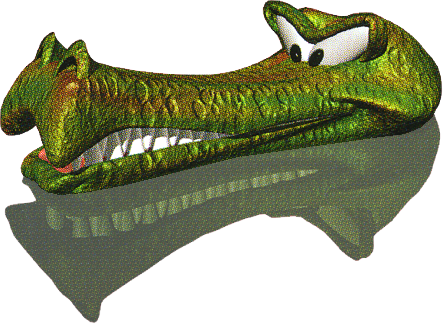
Name: Krockhead
Debut: Donkey Kong Country 2: Diddy's Kong Quest
What a normal guy. A very normal crocodile. And that's why it's weird! This normal crocodile works alongside the rest of the Kremlings, who walk on two legs, and wear clothes, and sometimes even wear nipples. I guess I can't prove that Krockhead does NOT do all these things under the water, but that sort of assumption would just be silly. And why would I be silly? No one's paying me to be silly. I need a believable motivation here.
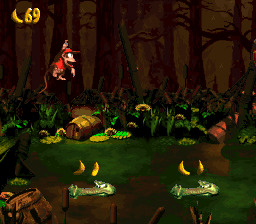
Krockheads are said to be "primitive" Kremlings, which I think pretty much cements them just being sort of Regular Crocodiles. And look, there they are! In The Swamp. Classic location! They are not really enemies, just Fun Aesthetic Platforms, though some of them do go in and out of the water. Also some of them are in lava instead of water! GEEET outta there! Biology Fact: animals can't go in lava! If they touch it, they are shot up at high speed going "yeowch! hachacha hot!"
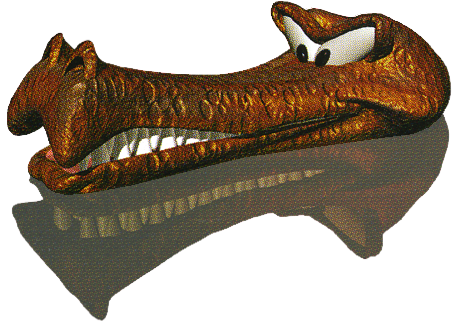
Aside from Classic Green, Krockhead also comes in Good Ol' Brown! These ones are silly springboards, and will open their mouths to launch whatever Kong stands on their snouts. This is the opposite of real crocodilians, who for all their bite strength, are notoriously weak at actually opening their mouths! Maybe this is a viable hunting strategy. I guess a predator does not need to crush prey in its jaws if it can fling a poor critter into the air and have it most likely die on impact! And then an opportunistic scavenger does not need ANY hunting capability to swoop in and steal the kill for itself. Sorry Krockhead! Outdone by Nature's Funny Tricks.
I really hope Krockheads are just not at all anthropomorphic, and that they are also recognized members of the Kremling Army. I hope they get paid. I hope they receive discounts at Krazy Kremland which they do not redeem because they do not have a concept of amusement parks.
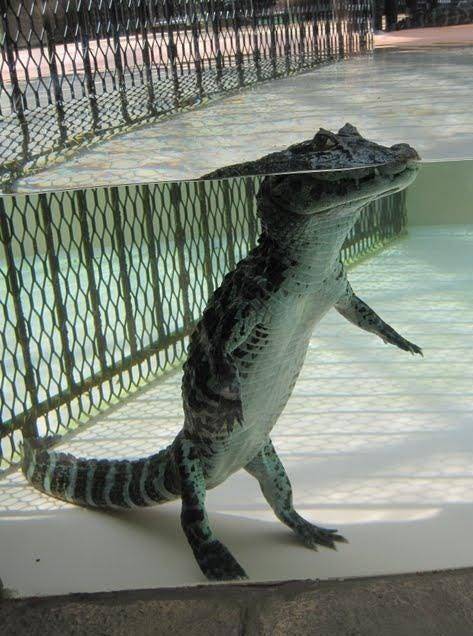
They probably look like this underwater. Hee hee
#krockhead#donkey kong country 2#donkey kong country 2 diddys kong quest#donkey kong country#donkey kong#mario#mario enemies#mod chikako
97 notes
·
View notes
Text
Spectember/Spectober 2023 #08: Various Filter-Feeders
Admantus asked for a "freshwater baleen whale":
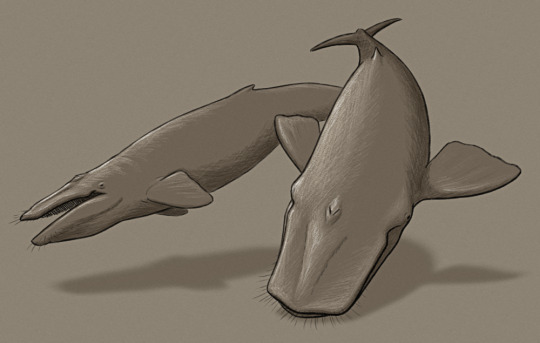
Rostrorutellum admantusi is descended from small cetotheres that became isolated in a large inland body of water (similar to the modern Caspian Sea), eventually becoming landlocked and gradually reducing in salinity towards fully freshwater.
Highly dwarfed in size, just 2-3m long (~6'6"-9'10"), they're slow swimmers with broad duck-like snouts that are used to scoop up mouthfuls of sediment and strain out their invertebrate prey in a similar feeding style to gray whales.
Due to the murkiness of the water, and the lack of large predators in their environment, they have poor eyesight and instead use sensory bristles and electroreceptors around their snouts to navigate and detect prey.
———
And an anonymous submission requested a "whale-like filter-feeding marine crocodile":

Sestrosuchus aigialus is a 6m long (~20') crocodilian closely related to the modern American crocodile, living in warm shallow coastal waters.
It's adapted for an almost fully aquatic lifestyle convergently similar to the ancient thalattosuchians, swimming with undulations of its long tail and steering with flipper-like limbs. But unlike other crocs it's specialized for filter-feeding, with numerous delicate needle-like teeth in its jaws that interlock to sieve out small fish and planktonic invertebrates from the water.
———
A couple more suggestions also asked for "fully aquatic pinnipeds" and "future crabeater seal evolution":

Euphausiolethrus volucer is a fully aquatic descendant of the crabeater seal. About 5m long (~16'4"), it occupies the ecological niche of a small baleen whale in the krill-abundant Antarctic waters that lack most actual baleen whales.
Its jaws contain numerous finely-lobed teeth that are used to strain krill from the water, and it utilizes all four of its wing-like flippers to swim in an "underwater flight" motion similar to that of plesiosaurs.
Highly social, it tends to congregate in pods that cooperate to herd swarms of krill for easier feeding.
#spectember#spectober#spectember 2023#speculative evolution#whale#cetacean#seal#pinniped#mammal#crocodile#pseudosuchia#archosaur#art#science illustration
263 notes
·
View notes
Text
*thinking process hardening*
I can't stop thinking about the possibility of being a draconic species instead. One that might look a bit like an alligator. A friend of mine and I also talked about it for a bit yesterday and she agreed that in the dream I either was a crocodilian or a draconian species. What she remembers is that I was looking a bit like the boy below, means I stood like that with the same or a similar size but more prominent scales (osteoderms or dragon scales, not sure).

I'd be happy about some input because although, I checked on draconian species before, my close-minded brain doesn't want me to believe that I might be draconian instead of a scientifically explainable existent reptile.
Do you have any draconian species that this position reminds you of? But with a wider snout? Alligator snouts might be very fitting.
#therian#alterhuman#otherkin#nonhuman#therianthropy#alterhumanity#reptilekin#alterhuman community#therianthrope#theriotype help
38 notes
·
View notes
Text
welcome to a little thing that might become a little series on my blog, idk. i just like to yap :)
theorized dragon anatomy and evolution, from someone who is an aspiring zoologist and really likes to study animals in his free time
sandwings:
shorter yet wider wings made for gliding, somewhat more connected to arms than other dragons (more wyvern like??) (idk sandwings are canonically built for long flights, but heat rises and it would be more beneficial for them to glide closer to the desert floor than up high where air would be hottest)
endothermic?? potentially, considering they still have very hot scales when not in the desert (means they have to eat more often than other tribes?? endothermy wastes a lot of energy. also adds into the gliding theory since if you are already producing your own bodily heat, you don't want to add to it and overheat)
closable ears like a camel + nictitating membrane in the eye to keep sand out during sandstorms?
rainwing/leafwing similarities:
canonically related tribes, where did they stem from??
one branch of the ancient tribe became leafwings, another became rainwings (gonna call them "junglewings" for now)
i guess it would be more interesting if the ancient tribe did not split before leafwings and beetlewings migrated to pantala
pyhrrian junglewings evolved into rainwings based on environment, pantalan junglewings evolved into leafwings?
^ this creates genetic bottlenecks for each tribe (they have less genetic diversity because they had to sweet home alabama since numbers were too low) (+ adds more lore to why rainwings genetically test one another before being allowed to mate)
junglewings had a similar parenting style to rainwings and leafwings?? biological parents play the biggest role in raising the dragonet, but communities still help raise the dragonets all together?
seawings:
why did bioluminescence evolve?? originally used for catching prey pre-scorching(?)
would echolocation play a part in the aquatic language? there's only so much one seawing could do with the bioluminescence, + the echolocation adds onto my earlier theory of prey catching
generally slimier/more skin-like scales than other tribes? (more amphibian-like due to their semiaquatic lifestyle)
chin thingies originally longer and used as lures for catching prey, became vestigial structures at some point?
longer, thinner snouts with cone-shaped teeth built for snatching up fish/other aquatic animals and swallowing them whole
nostrils/eyes more pointed up towards the sky so they can see/breathe above water while still being mostly submerged, like what is seen in crocodilians (potentially also seen in mudwings, who spend most of their time submerged in swamps. suggests mudwings and seawings are related tribes with a common ancestor like silks/hives and rains/leafs)
thinner, more streamline bodies that allow quick movement in water
tails are thicker, yet flatter (like a sea snake's or eel's) to be used as a paddle
i think seawings are underpowered, potential organ that can hold water to be sprayed at enemies (like c'mon, if we can have dragons that breathe fire out of nowhere, we can have dragons that spit water and actually have somewhere that it comes from)
#wof#wof leafwing#wof seawing#wof rainwing#wof sandwing#wings of fire#wings of fire headcanon#<- ig this counts as that?? idk#i may be insane and overthink a lot with my fandoms
20 notes
·
View notes
Text

Known for its tall, recognizable, cassowary-like crest, Corythoraptor jacobsi was a large oviraptorosaur also from the Nanxiong Formation of Late Cretaceous China. Corythoraptor’s crest was heavily pneumatized (full of air pockets), even more so than the modern day cassowary’s crest. This likely made the crest very light and fragile, even when covered by a keratinous sheath. It probably served a purpose similar to a cassowary’s crest: for display, to dissipate heat, and to detect low-frequency sounds.

The first, and only, known specimen was found to be at least 6 or 7 years old, having gone through seasonal growth spurts. This indicates that it lived in an environment that experienced fluctuating rainy and arid seasons. Corythoraptor likely used its toothless beak for eating plants, nuts, and seeds. However, since the Nanxiong Formation was home to many different species of oviraptorosaurs, it’s possible each one specialized in different types of food to avoid competition.

Corythoraptor had its first big spotlight in the documentary Prehistoric Planet, where it was seen eating Ginkgo seeds and being hunted by the long-snouted tyrannosaurid Qianzhousaurus, the apex predator of the Nanxiong Formation. It was also seen in the second season having its eggs stolen by the dromaeosaur Kuru kulla. While a welcome reversal of the common trope of always depicting oviraptorosaurs as egg thieves, Kuru did not live in the Nanxiong Formation, and was instead native to the slightly older Barun Goyot Formation of Mongolia. Corythoraptor would have instead shared the Nanxiong with other oviraptorosaurs like Tongtianlong, Ganzhousaurus, Huanansaurus, Jiangxisaurus, Shixinggia, Nankangia, and Banji, as well as therizinosaurids like Nanshiungosaurus, macronarian sauropods like Jiangxititan, indeterminate hadrosaurs, turtles, lizards, and the crocodilian Jiangxisuchus.


This art may be used for educational purposes, with credit, but please contact me first for permission before using my art. I would like to know where and how it is being used. If you don’t have something to add that was not already addressed in this caption, please do not repost this art. Thank you!
#Corythoraptor jacobsi#Corythoraptor#oviraptorid#oviraptorosaurs#theropods#saurischians#dinosaurs#archosaurs#archosauromorphs#reptiles#SaritaDrawsPalaeo#Nanxiong Formation#Late Cretaceous#China
27 notes
·
View notes
Text
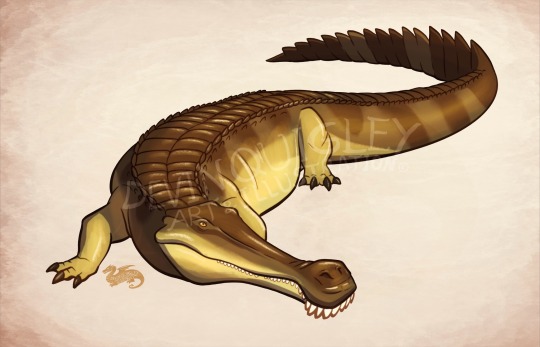
Paleovember 2023, Sarcosuchus!
Dating back to the Early Cretaceous, Sarcosuchus is a near-relative of modern crocodilians (not a true crocodilian itself) with species native to both Northern Africa and Brazil. The North African species, S. imperator, is estimated to measure up to 32 feet long! It's especially notable for the bulla, the large rounded portion of the end of the snout similar to the modern gharial. Unlike gharials, however, where the bulla is restricted to males, both sexes in Sarcosuchus seem to have a bulla, and while the gharial limits itself to eating fish, Sarcosuchus was more likely to be a generalist hunter of dinosaurs (though it wouldn't have been able to do the famous 'death roll' to rip it's prey apart).
#sarcosuchus#early cretaceous#pseudosuchia#crocodile#gharial#reptile#paleoart#paleontology#mesozoic#illustration#art#artwork#cartoon#digitalart#drawing#procreate#artist on tumblr
65 notes
·
View notes
Note
I've actually seen a few crocodile therians / alth, maybe like? One who is an artist on twt (I use their art as my banner!) And I always get so excited seeing more croc's cause I just think they're so cool so seeing one on the internet is super hype
What's it like being crocodile? Like what instincts do you feel and if you get shifts, what are they like? How did you come to realize youre a crocodile? Honestly just rant about being a big reptile crocodile in general, I'm so curious to know!
Only if you're comfortable ofc!
this is such a nice question to get :} it's even better since i need something to do atm, i'm currently stuck on an hour long bus ride -
being crocodilian is certainly interesting, and there are some urges that come with it. most often, it's the urge to eat raw meat (yes i know how common this urge is) however, this most often comes in the form of eating raw fish.
suprisingly, this isn't typically an issue for me, since i work at a grocery store that offers some pretty damn good sushi, but you know, it's pretty difficult to avoid the desire to bite into a slab of tuna every once in a while.
white this urge is common- it's not exclusive to my shifts. interestingly enough, my shifts have been coming around more and more often recently. crocodiles are social creatures, and i find myself most often shifting when around others (which is a little inconvenient, but not damaging). They usually take the form of phantom / astral limbs, most commonly tail, but i have had shifts with snouts and back ridges as well. however, i've also had issues with something i internally call "size dysphoria", you know, since being a 5'9 person isn't comparable to being a 15 ft long reptile. it's typically a little uncomfortable, but it doesn't last long and can be managed.
now, the question. how did i realize i was a crocodile? honestly, i don't really know. it's just something i came to one day. i've always been attatched to reptiles- particularly crocodiles. my friend, who is a wolf therian, introduced me to theriantropy at age 16. it was over time i began to realize that my connection to crocodiles ran deeper than i thought - i already had these cravings for raw fish, but honestly i just thought i liked sushi. it hit me just suddenly one day that i may be a crocodile therian- i asked my friend, told him my experiences, and sure enough, i was experiencing the same things as him. I also researched my species at this time, in all honesty, I'm still not sure, I'm either a nile or saltwater crocodile though.
that's really all i can think of at this time for my experiences, maybe i'll come up with some later and add on? but anyways, thanks for the question !! it's much appreciated, and feel free to ask anything else you'd like :}
#i absolutely love this question. tysm :}#<> open your jaw <>#otherkin#therian#alterhuman#nonhuman#therianthropy#reptilekin#crocodile therian#crocodilekin
29 notes
·
View notes
Note

[Addie glanced up at the sound of the ping, trying quickly to dry their eyes. The sight of the message alone perked their mood, and they adorned a small (but still sad) smile.]
"Well, Owl is... very pissed. I mean, I knew they would be, but... they refuse to move on, even though Kinito looks fine and everything has already gotten so much better."
[They blow a stray strand of hair from their face, trying to distract from their emotions.]
"But... I... Have to accept that. I mean, I'm not exactly innocent here; I did intentionally go behind their back. I just hope they realize one day that it was the best thing to do for everyone..."
[They sigh again, rubbing their temples. Their tongue flicks again - the odd smell is much stronger. It smelled like... mud and swampwater? Like... Blood... and...]

[A 12 foot crocodilian explodes through Addie's handmade doorway, and when he lands he releases a loud, bone-rattling bellow that makes Addie's ears ring. Rearing to full height, his head nearly scraped the ceiling. He glared down at Addie, assessing them with fire in his eyes, his pupils flitting to and fro as disgust caused his snout to wrinkle.]
"You're fucking h i d e o u s."
[He snarled, and the volume of the phrase wasn't the only part of it that made Addie's head spin.]
[In the blink of an eye he was on them, gleaming teeth inches from the smaller reptile's face.]
"Your "loss" will not be mourned."
[Before Addie could process those last words, a paralyzing pain erupted in their abdomen as the croc snatched them in his jaws, their raw screams echoing within the small cave as their flesh was pierced and their ribs cracked from the pressure.]
[As this went down, two other crocodilians slinked into the cave as well, with one quietly grabbing hold of Addie's tail and brandishing what appeared to be a meat cleaver, and the other hanging by the broken down entrance, shaking like a leaf.]

"....A....Addie?!"

"ADDIE..?!"
[The only thing that filled his ears was the sound of screaming. The cries and wails of agony that flooded the space. The excruciating pain, A tone of Addie's voice that he never wanted nor thought he would ever have to here]
[A crackle of electricity burns in his body, teeth gritting so hard that they began to hurt and a bitter taste filling his mouth.]
[Visions began to flash in Sonny Chamberlain's eyes, a horrible spinning feeling overtaking his head as he recalled how it... it always ended like this.]
[Always. Every single person, regardless of contact, it would always end like this. Somehow. Someway. They would die. Again and again and again.]

[Again and again and again he would FAIL he's always FAILED. And now he's going to lose the one he loves because he can't DO anything]

[He's NEVER been able to do anything.]
[....]
[But this time he can.]
[He can do something]
[He will have to go against everything he's ever told himself, every rule that he has set in place-]
[But he won't fail again.]
----
[A loud, earsplitting crackle ripples through the den, a pulse of electricity sparking through the plugs and ports that shudders through the old pc. The crackling, the shrieking of static and wires only continued to grow louder, erratic, shooting through the ground.]
[Until it goes quiet. The screen goes entirely black.]
[...]
[A hand pushes itself through the screen, shifting and warping, an undecipherable shape protruding through the black.]
[The tips of octopus tendrils grip onto the sides of the monitor, crackling with energy as a mass forces itself out. An impossible phenomena- It almost hurt to look at.]
[A hulking, jet black figure of nearly eight feet removes itself from the yellowed plastic casing, a roar of static surge dripping from it. It was almost featureless, face entirely overshadowed in darkness- The only thing that anyone was able to make out were multiple, burning white eyes that blinked in and out like flickering, flaming stars.]
[They were perhaps waiting for it to speak.]
[It didn't.]
[Sonny didn't even give a warning before one of those long, dripping tendrils latched around the offending crocodile's neck and Sharp serrated teeth began to dig past the hide.]
10 notes
·
View notes
Text
Is It Ok For An Alligator To Have Tape On Their Mouth?
Alligators make pretty amazing animal ambassadors when handled safely and ethically. And it is actually pretty safe to take them out to interact with the zoo-going public (or general public in some settings), when done correctly. Many zoos and outreach organizations do an amazing job of this! Every state has different rules, but even if a state doesn't mandate that alligators be banded... well, if you're a responsible crocodilian handler, you'll band anyways. It's a huge public safety issue! Even an accidental graze against their front teeth can cause injury. See, the alligators that are used as handle-able ambassadors are pretty small, and their teeth are razor sharp. An adult gator has sharp teeth, too, as well as blunt teeth for crushing, and they also have the additional force of their jaw muscles.
Here's what it sounds like when an adult alligator pops his jaw. (Don't worry about the hissing/gaping; this is a trained and queued behavior. The stick towards the top of the inside of the mouth is triggering the bite reflex. Chester probably got lots of chicken and fish as he learned to do this.)
youtube
Skip ahead to 0:32 if you wanna skip the guest commentary.
What's more, biting is an important reflex for crocodilians. The lower jaws of crocodilians are some of the most innervated tissues in the animal kingdom; they are more sensitive than human fingertips! Even the slightest touch triggers their bite reflex, which likely is an adaptation that lets them detect changes in water pressure that signal a snack heading their way.
Here's a pretty good video about the biomechanics of crocodilian jaws:
youtube
So yeah. They need to not be able to bite for public safety. There's just too much risk involved with an unbanded alligator (or other crocodilian). Fortunately, it's easy to get a crocodilian to not bite- you just need to band its mouth!
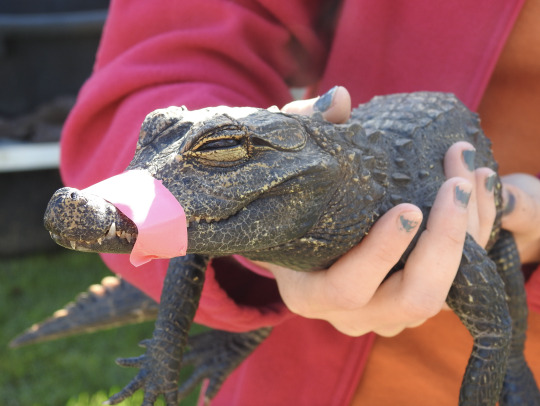
(This fella is Frodo the dwarf caiman, but the principle is the same.)
This works because while crocodilians have an extremely strong bite force (claims range from 2,000 PSI to 5,000+ PSI, but I don't have time to get into that now but someday I will probably), but not particularly strong muscles to open their mouths. Selective pressure for quickly nabbing prey in murky water where there's not a lot of visibility lead to pterygoid and adductor muscles so big, they extend into the animal's neck. But those muscles only pull the jaw closed- they don't work to open it! That's why you see people holding an alligator's mouth closed with their hands.
Safe bands include:
Silicone tape- this is the best. It sticks to itself and not the gator's snout
Electrical tape
Medical tape
Rubber or elastic bands
There are other options, but these are the most popular- they're cheap, easily available, and safe. So if you see an alligator (or other crocodilian) out in public and it's got tape on its mouth, don't worry too much- it's safe for the gator (most of the time) and it's safe for you!
Here's a couple of safe tape options, modeled by a juvenile American alligator in pink electrical tape (I forget her name, these are from an outreach event a couple of years ago) and Pagasa, a juvenile Philippine crocodile wearing the white medical tape.
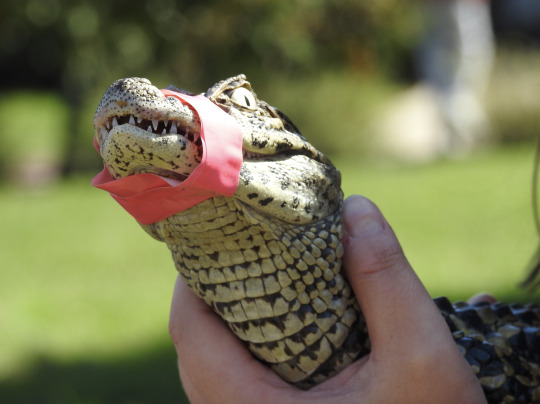
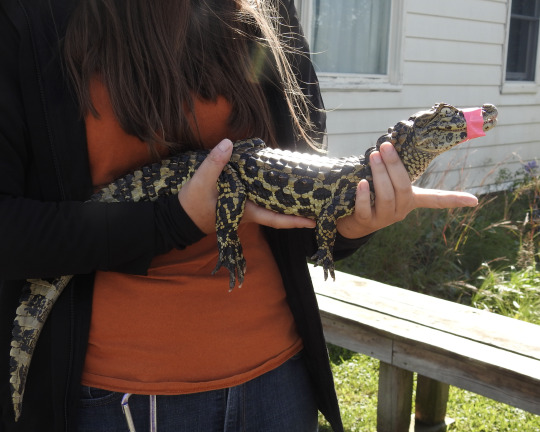
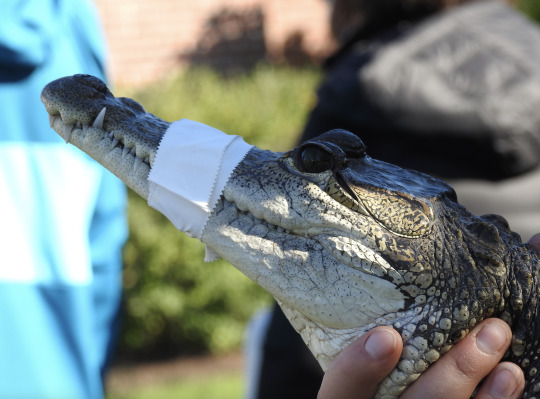
So when is tape not safe? When it's the wrong kind of tape. One of the worst offenders is duct tape.
When you're banding an alligator, you need to think about how sensitive their jaws are. A band that's too tight or too sticky can hurt them badly when it's removed- and you want that removal process to be fast, so that it doesn't stress them out too much.
What inspired this post was this picture I saw on Facebook:
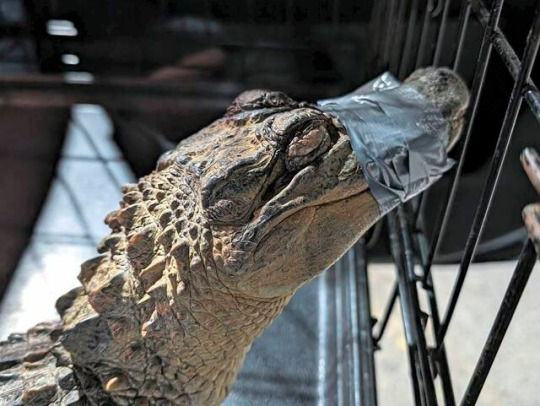
That's so much duct tape! Now, this little guy is quite unhealthy; he's been loose in the Pittsburgh area all winter, and he's been struggling. What you see here is a very quick tape job done as he's getting ready for transport. The article didn't say who taped him, but given that he's in a dog crate and was found by bicyclists, I would wager that it was some harried animal control officer who was doing the best they could. And that's fine because this was truly an emergency situation. In an emergency situation, uncomfortable is always, always better than unsafe.
But if you see a tourist attraction and they've put duct tape on their alligator's mouth? That's a red flag! Banding an alligator in public is the safe, correct thing to do- you just want to make sure that it's done right.
If you want more information about alligator jaws, here's some interesting papers to read:
Erickson, Gregory et al. Insights into the Ecology and Evolutionary Success of Crocodilians Revealed through Bite-Force and Tooth-Pressure Experimentation. PLoS ONE 7(3): e31781.
Knight, Kathryn. Croc Jaws More Sensitive Than Human Fingertips. Journal of Experimental Biology (2012) 215.
Sellers et al. Ontogeny of bite force in a validated biomechanical model of the American alligator. Journal of Experimental Biology (2017), 220.
665 notes
·
View notes
Text
Croc colours and patterns
Somewhat inspired by a recent post by Joschua Knüppe, I feel like it's a good thing to remind people just how diverse colours and patterns in modern crocodilians are. When I see people make art, it often seems to stick to grey or yellowish-brown tones, which is of course not incorrect. But theres a lot of, imo, underappreciated variety still. It's also worth noting beforehand that patterns are most striking in younger individuals and naturally become more muddy the older and larger an animal becomes. But as you will see, even some decently large and old animals may maintain a striking appearance.
Take this alligator for example. Gators tend to be on the darker side, dark greys to black, sometimes countershaded and sometimes pretty consistent. Some individuals, like this one photographed by Gar Luc, still retain clearly visible stripe patterns from when they are younger.
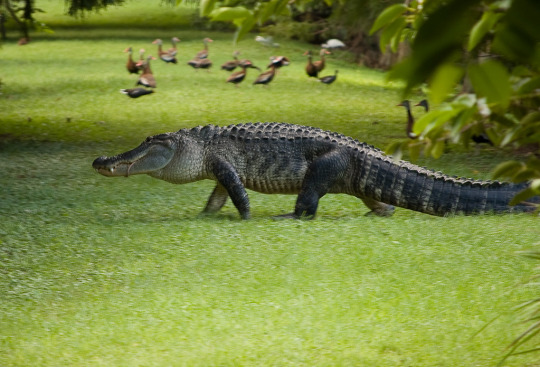
Or take one of my favourite species, the Cuban Crocodile, which can appear almost bright yellow with a dense pattern of leopard spots. Of course like with the gator you can find individuals that are much more drab, with washed out colours, but individuals with clearly defined patterns still exist.


Then there's gharials of course. They can range quite a bit in colouration. They can be brown, especially younger ones and females and I've seen males range in colour from a drab grey to almost a light blue or even something that could be described as metalic black.
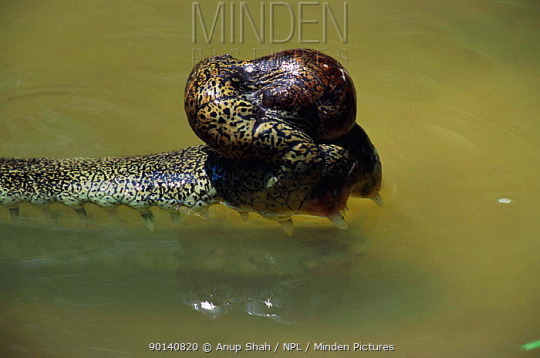
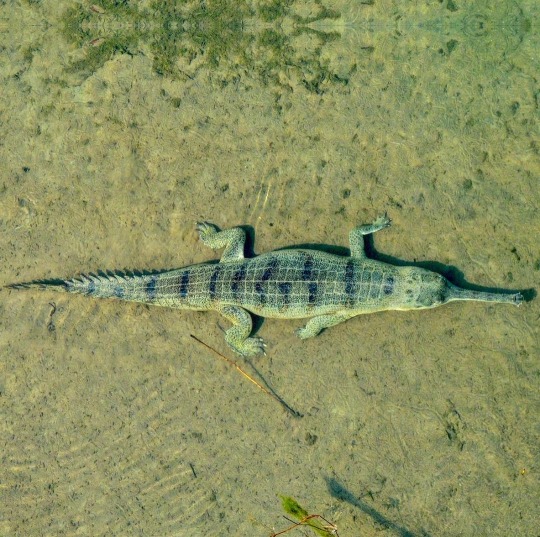
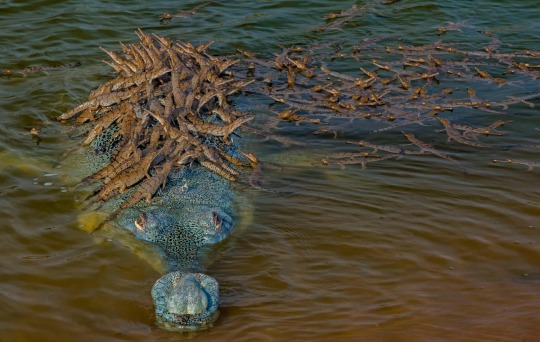
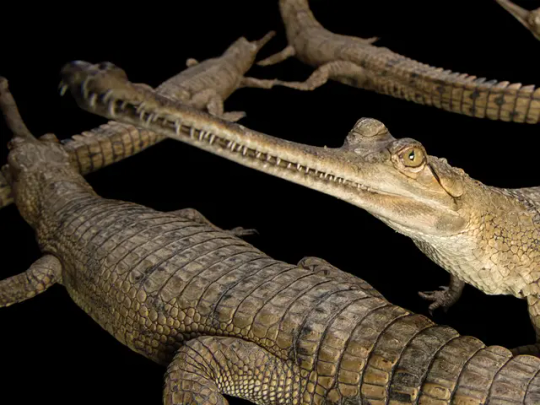
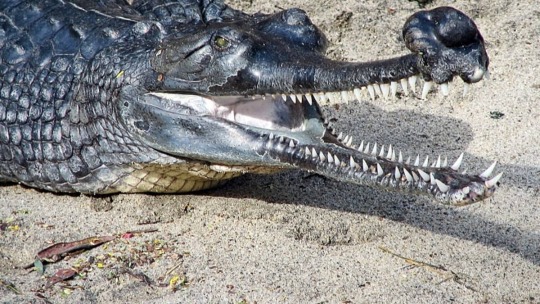
Black Caimans are also pretty interesting in my opinion and pretty easy to tell apart from other species once you pay attention to their colour. They are primarily a deep dark black of course, but what sets them apart from spectacled and other caimans is that very fine pattern of thin white stripes across the flanks that creates this beautiful contrast. They can also have patches of brown like the one on the right.


Orinocos also vary a great deal. Tho I know less about them than I wish I did, I know that individuals can range from drab brownish greys to yellow to somewhat earthy browns that almost range into reds.


The next ones a bit of an outlier. There are specific cave dwelling dwarf crocodile populations in western Africa with striking orange colouration. Tho this one is not exactly natural pigmentation to my knowledge and instead the result of the chemicals present in the water they inhabit, brought there by bat guano. Still very pretty animals.
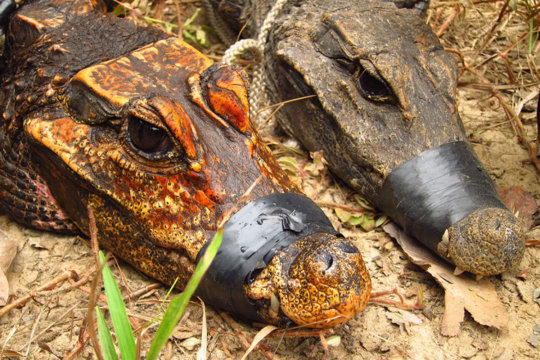
And then there's Paleosuchus, the dwarf caiman which contains two species. Again highly varied. The first image, which I believe is a Schneider's dwarf caiman, shows a very earthy brown. The others, which unless I'm mistaken are Cuvier's dwarf caimans, show colours ranging from dark with a rusty head, black to this still beautifully patterned individual. Of course these variations are also subject to change with age.
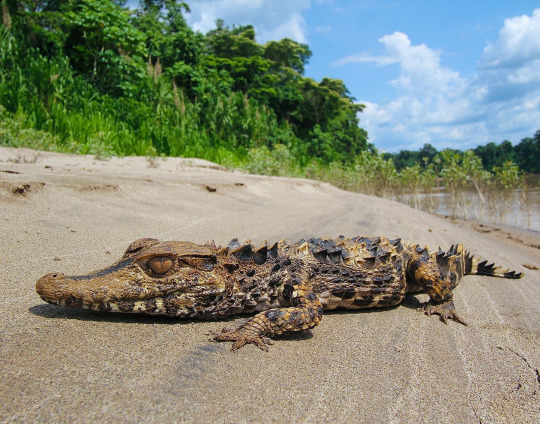
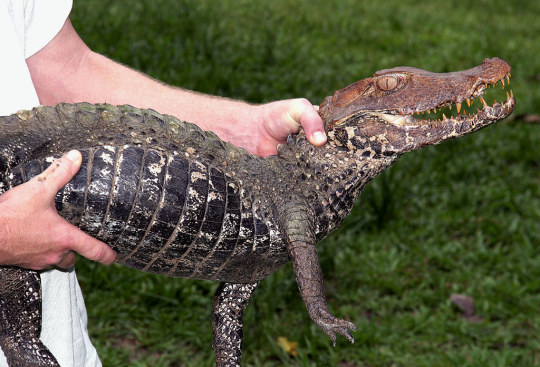
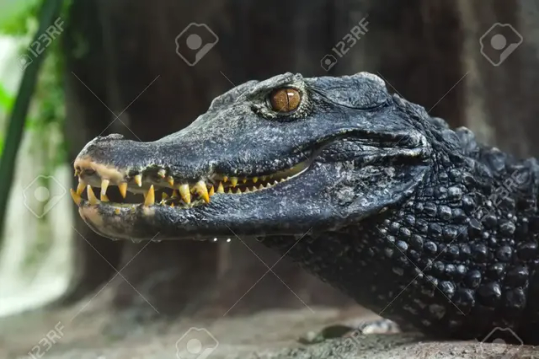
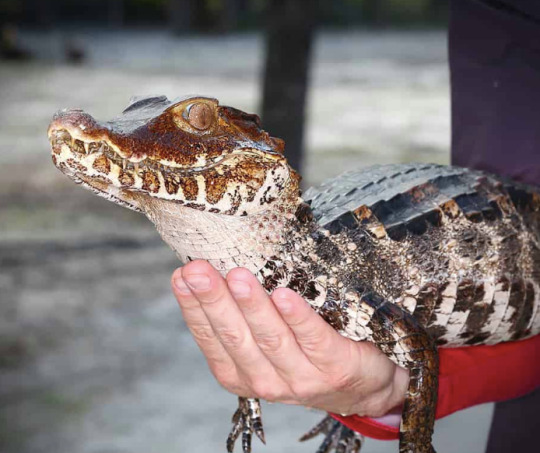
While salties aren't exactly known to be the most vibrant, I'd be remissed if I didn't mention this specific one. It's kept in a zoo in Germany and has this almost bizarre colour combination of creamy white underbelly and chocolate brown top which I've never seen in another saltwater crocodile. Photos by my friends Markus Bühler from the Bestiarium blog and René Dederich

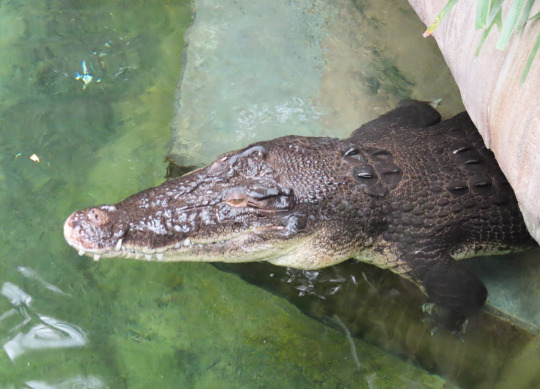
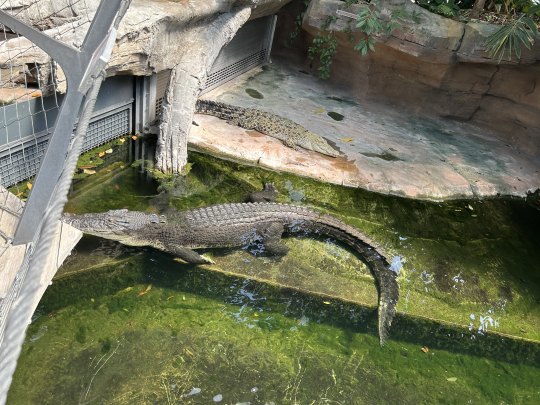
Spectacled, Broad-snouted and Yacare caimans I'll give a quick shout out. I think most people are familiar enough with how they look like and while their colours aren't anything special, I still think one should appreciate their patterns of spots and stripes and facial markings.

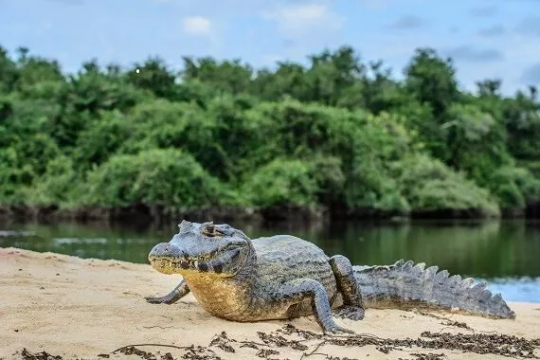
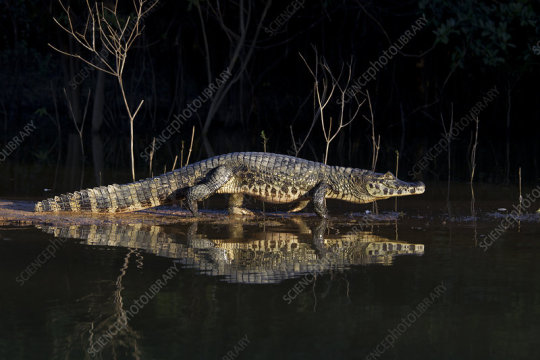
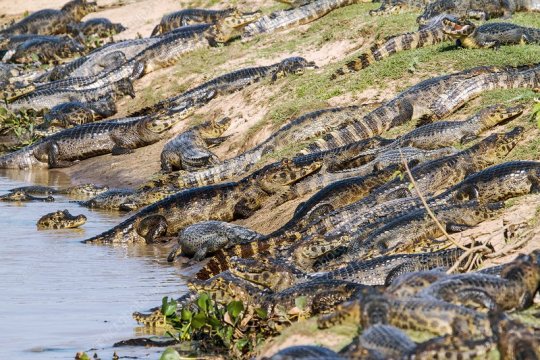
The last one I wanna highlight is the false gharial, Tomistoma, another one of my favourites. Part of the reason why being its at times beautiful reddish-brown colours.
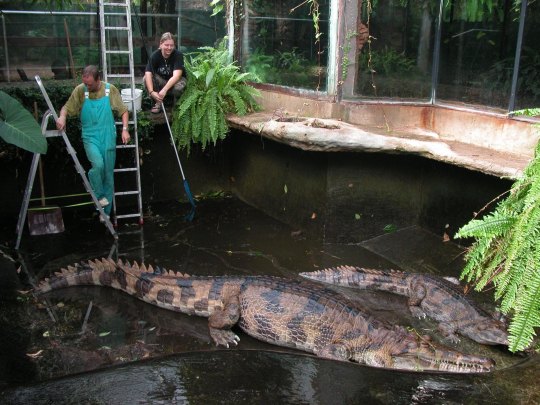
#crocodiles#crocs#gharial#gator#alligator#crocodilian#herpetology#reference#colours#inspiration#paleoart inspiration
2K notes
·
View notes
Text
The taxonomy of Sly Cooper: Part 2
So, the first entry of this series was pretty well-received. Here's part two. This time we'll be focusing of the villains of the first Sly-game, The Fiendish FIve.
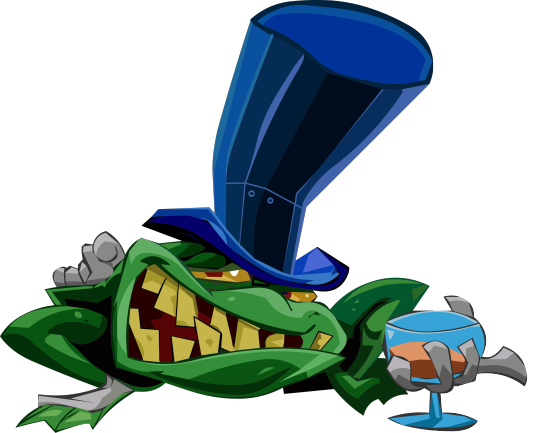
Raleigh was actually kinda difficult to pin down, as he is pretty much just a generic non-descript frog. Looking at a list of amphibians in the British Isles didn't exactly narrow it down, as the UK also has several non-native species of frogs with varying degrees of naturalization. Eventually I settled with the species that I thought best matched his colouration, the marsh frog (Pelophylax ridibundus)
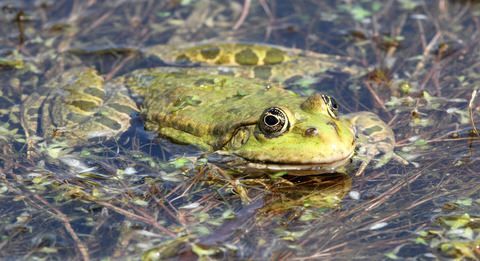
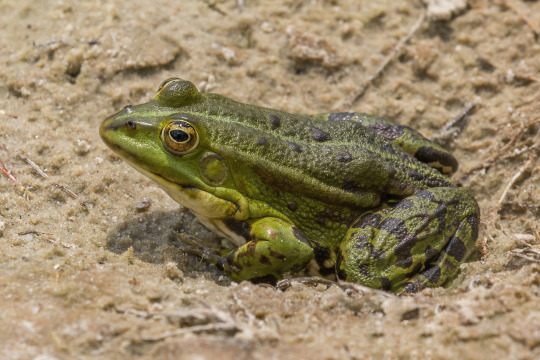
At up to 4 inches long, the marsh frog is the largest and one of the most widespread frog-species native to Europe, although it isn't native to the UK, being introduced in the 1930's. Within the UK it is primarily found in south-eastern England. Researchers are still undecided as to wether or not it poses a threat to the local ecosystem.
True to their name, marsh frogs are generally found in marsh regions, being more tolerant of saltwater and pollution than other frog-species. Like most frogs they primarily feed on insects and other invertebrates, but thanks to their size they can also prey on smaller fish, birds, and rodents.


In contrast, Muggshot was fairly easy to figure out. He is unsurspirisngly an american bulldog, particularly of what is called the "bully"-type. Domestic breeds generally aren't my forté, but I'll do my best.
American bulldogs were originally an offshoot of the english bulldog, which were brought to America following the colonization, where they were primarily used as livestock guardians and catch dogs. The "bully"-type ( also known as the "Johnson" or "Classic"-type) was created by dog-breeder John D. Johnson in the mid 19th-century, by crossbreeding standard american bulldogs with an english bulldog, resulting in a line of dogs that are bigger, more muscular, and with a more pronounced underbite than the standard variation, all very reminiscent of Muggshot.
Primarily used as guard dogs nowadays, american bulldogs are considered to be a loyal and courageous breed with strong protective insitncts. They riquire rigourous training and exercise in order to stay healthy (and make sure they don't skip leg-day, like a certain someone)
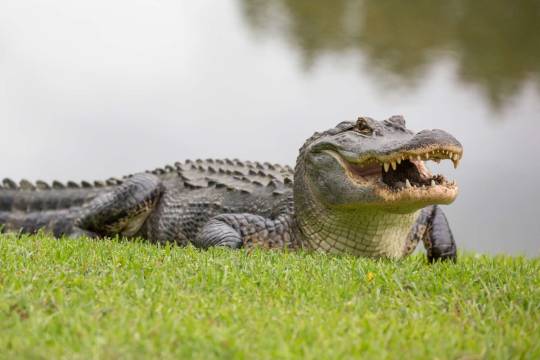
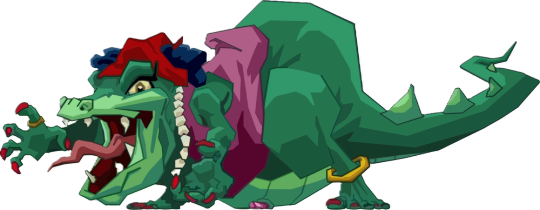
Mz. Ruby also proved to be alittle bit tricky. I had originally pinned her as an american crocodile (Crocodylus acutus) given that she lives in Haiti, where the only native crocodillian is the american crocodile. The Sly Cooper Wiki refers to her as an american alligator (Alligator missisipiensis), but there is nothing in-game that confirms this. However, i then realized that she is probably Cajun given her accent. The Cajun culture originates in Louisiana, where the only crocodilians are american alligators, so that kinda seals the deal.
You wouldn't really know that just by looking at her though. Alligators are distinquished by having short, broad snouts with an overbite. If we look at Mz. Ruby, while her her snout is kinda broad, she sure as hell doesn't have an overbite.
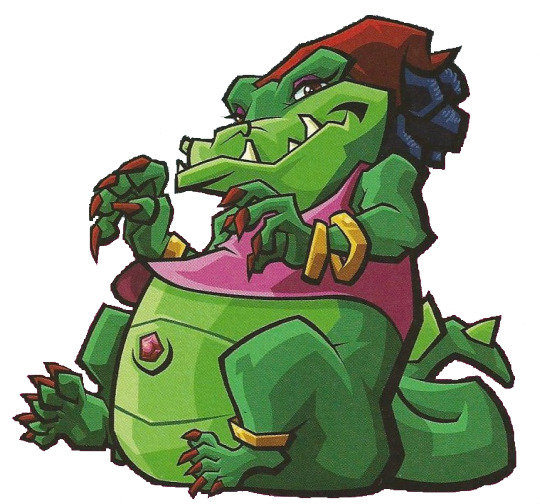
Petty taxonomy bullshit aside, american alligators are found throughout the swamps, rivers, and lakes of the south-eastern United States. They are the apex predators of their environment, and eat pretty much any animal they can get their jaws on. Although their range overlaps with that of the american crocodile in Florida, the two species generally don't compete over resources.
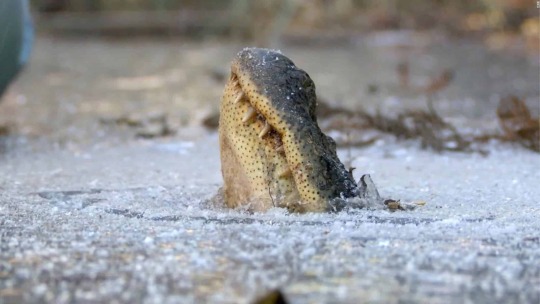
American alligators are some of the most cold-resistant reptiles, being able to survive temperatures as low as 40 degrees fahrenheit or 7 degrees celsius. Should the water they live in freeze over they can go into a kind of suspended animation, by digging a hole in the ice to breathe through, whilst lowering their metabolism and bodily functions to a minimum. Not quite the breaking of the laws of life and death that Mz. Ruby has got going on, but still pretty cool.
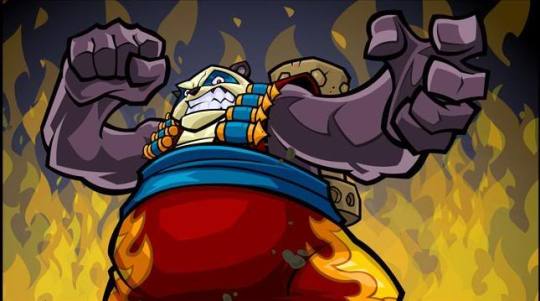

Moving unto the Panda King, and yeah... There is no getting around the fact that he is clearly meant to be a giant panda (Ailuropoda melanoleuca). I briefly toyed with the idea of him being one of the many extinct species of Ailuropoda, but that was too far-fetched.
Giant pandas are of course renowned for their cute appearance, strict bamboo diet, and for being the face of animal conservation. Though infamously endangered by habitat-loss in their native mountain range, they are considered less endangered nowadays, being given the IUCN-status of Vulnerable.
And no, pandas aren't an evolutionary dead-end or a lost cause in terms of conservation, and don't deserve to go extinct. Anyone who tells you otherwise likely doesn't understand ecology.
The giant panda is notable for having an extra long sesamoid bone on its front paws, in additon to its five fingers. While not a true finger, this bone practically works like an opposable thumb, which comes in handy when handling bamboo shoots (though it'll take some time before they master the art of pyrotechnics)
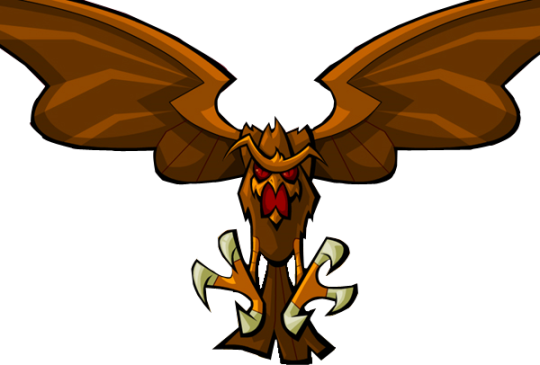

Finally we have Clockwerk, the immortal arch-nemesis of the Cooper Clan. His in-game description doesn't give us much to work with, other than that he is an owl of some kind. We do know that he apparently had an orange plumage before becoming a cyborg. Due to his large size and having a base in Russia, some people have identified him as a eurasian eagle-owl (Bubo bubo), which I can defintiely see.
I however subscribe to the theory that Clokcwerk was originally from Ancient Egypt, and thus like to think that he's a pharaoh eagle-owl (Bubo ascalaphus).
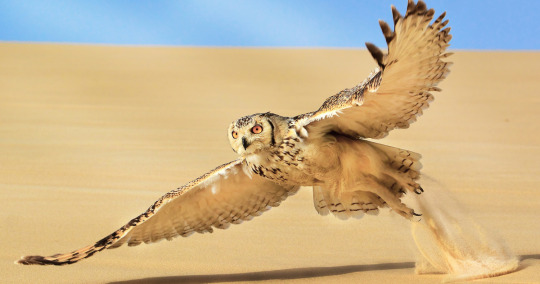
With a wingspan of about 3 feet, the pharaoh eagle-owl is actually one of the smaller members of its genus. It is found throughout Northern Africa along with parts of the Arabian Peninsula. It likes to nest around cliffs and river valleys, where it primarily feeds on rodents, reptiles, and other birds, but occasionally takes on prey as large as hares and desert foxes.
The ancient egyptians associated the owls with wisdom and knowledge, but also regarded them as symbols of mourning and death. Owls were sometimes mummified alongside humans, as it was believed that their night-vision would help guide the deceased through the darkness of the underworld.
15 notes
·
View notes
Note
Ok so I know you're not officially taking requests yet but this popped into my head and I just had to share it because I thought it was adorable and figured you might as well.
Its been pretty unanimously decided that Reptile is very inexperienced with pretty much anything human related, especially trying to flirt with someone. So say someone did catch his eye and he's trying his absolute hardest to flirt but of course they're human so they're not picking up on his signals. Feeling pretty dejected from that, who would probably be the best person to ask for advice? Bi-Han! I just picture that Reptile would probably be completely mystified about human mating customs and full of Why? questions and Bi-Han trying to keep a straight face explaining why a human wouldn't understand that him giving them a very nice rock means he's attracted to them. (Lizards like smooth flat rocks to lay on, so that's what my mind came up with.)
Yeeeeessssss Syzoth giving his s/o pretty rocks is so cute! I mentioned it in another post but crocodiles blow bubbles while courting their potential mates so I see Syzoth blowing bubbles in drinks around his s/o too! Another thing crocodiles do is rub their snouts together so Syzoth likes to rub noses with his s/o. I tend to follow a lot of crocodilian things for Syzoth because I happen to love crocodiles. I also know more about them than lizards, all I really know about lizards is they like sunny rocks and bugs lol I totally love the idea of Syzoth loving sunny rocks though
Poor Bi-Han having to explain everything to Syzoth lol it’s just like having to explain everything to his brothers all over again.
Syzoth: look at this pretty rock! Sunshine will love it!
Bi-Han: humans don’t care about rocks unless they’re diamonds.
Syzoth: what? Why?! It’s so smooth and flat! They’ll love it!
Bi-Han: *pinching the bridge or his nose* no, no they won’t, that’s not how humans work…
Syzoth: Well, how about I blow a lot of bubbles! Surely that will convey my interest!
Bi-Han: WTF are you five? Only children do that! *exasperated sigh*
Syzoth: no trust me, bubbles are a sure fire bet!
Bi-Han: *throws his arms up* fine Sy, do what you want!
54 notes
·
View notes